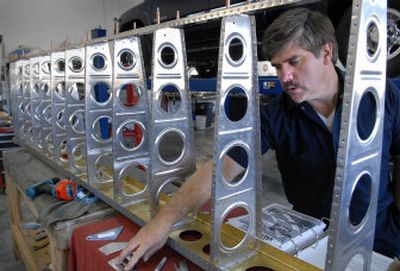Waiting to be cleared for takeoff

Cheryl Allbee’s husband, Steve, wanted to fly. He talked about big planes constantly and spent his weekends flying little remote ones he’d built from scratch just to keep his demon down.
Cheryl went out to the mailbox one day and found an invitation to a flight school open house. She held on to it, sure that the moment she presented it to Steve, their lives would change forever. She was right.
“It was something that I understood eventually we’re going to do,” Cheryl Allbee said. “I knew from the time we got married that he had this deep interest in flying.”
They went to Geiger Field. Steve hopped in the left front seat of a small Cessna, the left seat being the business seat in a tiny airplane, just as it is in a car. He got the propeller spinning, just as the instructor seated beside him told him to, and taxied down the runway with Cheryl in the backseat.
Oh, how easy that first flight was. Steve was a natural. The flight instructor let the newcomer work the controls uninterrupted as they flew in the shadow of the busiest airport in the region, not to mention within a stone’s throw of Fairchild Air Force Base.
How easy the next step would have been, had Steve been born with wings.
But every private pilot since Daedalus, who crafted his wings of wax and feathers, or at least every pilot without $70,000 for a used plane, has had to build his own.
Last Thursday, between repair jobs at Custom Transmission, the Allbee family business, Steve trued featherweight pieces of aluminum that make up the wings of a Van’s RV plane, a sort of Erector Set for adults determined to leave Earth. A used plane might cost as much, but the do-it-yourselfers of aviation insist building from scratch gives you more plane for your buck. And you can pay as you go, one piece at a time spread over several years.
“Sure,” Steve said. “You could go out and fly an airplane that’s already been flown, but that doesn’t give you the bubbles and the goose bumps like one you built on your own.”
Building a plane is never easy. Steve has been working on this one since 2004, driving rivets when he can, buying plane segments when he can. Van’s sells the pieces a few at a time to keep a pilot’s budget from breaking. Between construction phases, Steve keeps the parts covered by a tarp so he doesn’t have to look at them. He steers clear of Van’s RV owners so he doesn’t have to hear about what he wants so badly.
The average pilot flies less than 90 hours a year, according to insurance underwriters. Building a plane takes thousands of hours. By the time a hobby builder rolls his creation out of the shop, there’s a good chance he won’t have enough pilot left in him to leave the ground safely.
Steve doesn’t seem at risk of losing his touch. He’s logged 550 hours of flying time since first taking to the air in early 2003. He has a used plane that he shortened the wings on for agility’s sake, but he insists that aircraft is nothing like the one he’s building.
It’s lunchtime and Steve is working on the Van’s RV, while an oldies radio station plays in the background and Cheryl takes business calls in the office.
“You haven’t flown until you fly at night. When you fly over the city to land, that’s the coolest thing in the world,” Steve said. He says you haven’t seen the world until you see it from a distance, when things that make a landscape so unattractive from the ground are scarcely visible and the big picture is so beautiful. A person just can’t stay away after seeing that, Steve says. It’s enough to make a guy sprout wings.